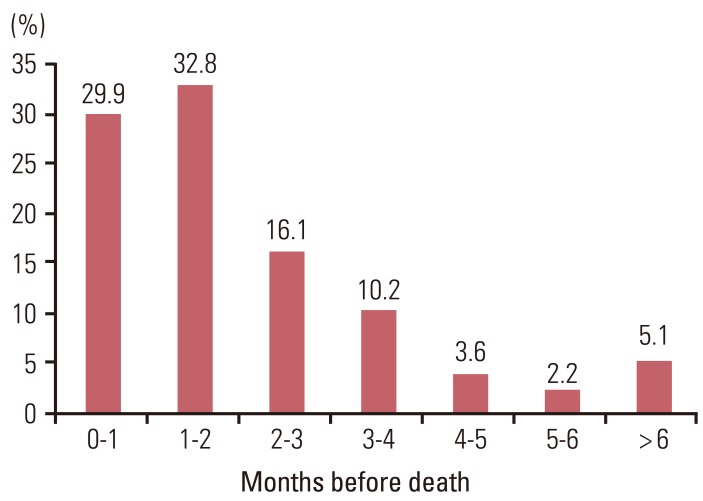Cancer Res Treat.
2013 Dec;45(4):270-275.
Trends in the Aggressiveness of End-of-Life Care for Advanced Stomach Cancer Patients
- Affiliations
-
- 1Division of Medical Oncology, Department of Internal Medicine, Seoul St. Mary's Hospital, The Catholic University of Korea College of Medicine, Seoul, Korea. y331@catholic.ac.kr
Abstract
- PURPOSE
It is important to balance the appropriateness of active cancer treatments and end-of-life care to improve the quality of life for terminally ill cancer patients. This study describes the treatment patterns and end-of-life care in terminal gastric cancer patients.
MATERIALS AND METHODS
We retrospectively analyzed the records of 137 patients with advanced gastric cancer receiving chemotherapy and dying between June 1, 2006 and May 31, 2011. We recorded interval between last chemotherapy dose and death; frequency of emergency room visits or admission to the intensive care unit in the last month before death; rate of hospice referral and agreement with written do-not-resuscitate orders; and change in laboratory values in the last three months before death.
RESULTS
During the last six months of life, 130 patients (94.9%) received palliative chemotherapy; 86 (62.7%) during the final two months; 41 (29.9%) during the final month. During the final month, 53 patients (38.7%) visited an emergency room more than once; 21 (15.3%) were admitted to the intensive care unit. Hospice referral occurred in 54% (74 patients) of the patients; 93.4% (128 patients) gave written do-not-resuscitate orders. Platelets, aspartate aminotransferase and creatinine changed significantly two weeks before death; total bilirubin, one month before; and C-reactive protein, between four and two weeks before death.
CONCLUSION
Our results demonstrated that a significant proportion of gastric cancer patients received palliative chemotherapy to the end of life and the patients who stopped the chemotherapy at least one month before death had a lower rate of intensive care unit admission and longer overall survival than those who sustained aggressive chemotherapy until the last months of their lives.
MeSH Terms
-
Aspartate Aminotransferases
Bilirubin
Blood Platelets
C-Reactive Protein
Creatinine
Drug Therapy
Emergencies
Hospices
Humans
Intensive Care Units
Quality of Life
Referral and Consultation
Resuscitation Orders
Retrospective Studies
Stomach Neoplasms*
Stomach*
Terminally Ill
Aspartate Aminotransferases
Bilirubin
C-Reactive Protein
Creatinine
Figure
Reference
-
1. Ho TH, Barbera L, Saskin R, Lu H, Neville BA, Earle CC. Trends in the aggressiveness of end-of-life cancer care in the universal health care system of Ontario, Canada. J Clin Oncol. 2011; 29:1587–1591. PMID: 21402603.
Article2. Cancer pain relief and palliative care. Report of a WHO Expert Committee. World Health Organ Tech Rep Ser. 1990; 804:1–75. PMID: 1702248.3. Earle CC, Park ER, Lai B, Weeks JC, Ayanian JZ, Block S. Identifying potential indicators of the quality of end-of-life cancer care from administrative data. J Clin Oncol. 2003; 21:1133–1138. PMID: 12637481.
Article4. Gagnon B, Mayo NE, Hanley J, MacDonald N. Pattern of care at the end of life: does age make a difference in what happens to women with breast cancer? J Clin Oncol. 2004; 22:3458–3465. PMID: 15277537.
Article5. Keam B, Oh DY, Lee SH, Kim DW, Kim MR, Im SA, et al. Aggressiveness of cancer-care near the end-of-life in Korea. Jpn J Clin Oncol. 2008; 38:381–386. PMID: 18411260.
Article6. Braga S, Miranda A, Fonseca R, Passos-Coelho JL, Fernandes A, Costa JD, et al. The aggressiveness of cancer care in the last three months of life: a retrospective single centre analysis. Psychooncology. 2007; 16:863–868. PMID: 17245696.
Article7. Koizumi W, Narahara H, Hara T, Takagane A, Akiya T, Takagi M, et al. S-1 plus cisplatin versus S-1 alone for first-line treatment of advanced gastric cancer (SPIRITS trial): a phase III trial. Lancet Oncol. 2008; 9:215–221. PMID: 18282805.
Article8. Kamangar F, Dores GM, Anderson WF. Patterns of cancer incidence, mortality, and prevalence across five continents: defining priorities to reduce cancer disparities in different geographic regions of the world. J Clin Oncol. 2006; 24:2137–2150. PMID: 16682732.
Article9. Lunney JR, Lynn J, Foley DJ, Lipson S, Guralnik JM. Patterns of functional decline at the end of life. JAMA. 2003; 289:2387–2392. PMID: 12746362.
Article10. Emanuel EJ, Young-Xu Y, Levinsky NG, Gazelle G, Saynina O, Ash AS. Chemotherapy use among Medicare beneficiaries at the end of life. Ann Intern Med. 2003; 138:639–643. PMID: 12693886.
Article11. Kao S, Shafiq J, Vardy J, Adams D. Use of chemotherapy at end of life in oncology patients. Ann Oncol. 2009; 20:1555–1559. PMID: 19468033.
Article12. Earle CC, Neville BA, Landrum MB, Ayanian JZ, Block SD, Weeks JC. Trends in the aggressiveness of cancer care near the end of life. J Clin Oncol. 2004; 22:315–321. PMID: 14722041.
Article13. Andreis F, Rizzi A, Rota L, Meriggi F, Mazzocchi M, Zaniboni A. Chemotherapy use at the end of life: a retrospective single centre experience analysis. Tumori. 2011; 97:30–34. PMID: 21528660.
Article14. Ngo-Metzger Q, McCarthy EP, Burns RB, Davis RB, Li FP, Phillips RS. Older Asian Americans and Pacific Islanders dying of cancer use hospice less frequently than older white patients. Am J Med. 2003; 115:47–53. PMID: 12867234.
Article
- Full Text Links
- Actions
-
Cited
- CITED
-
- Close
- Share
- Similar articles
-
- The Overview of Hospice Care as Urologist
- Psychological Aspects of Care in Cancer Patients in the Last Weeks/Days of Life
- A Mixed Method Study for Exploring the Difficulties in End-of-Life Care and End-of-Life Care Competency in Nurses Who Take Care of Cancer Patients
- Endoscopic Treatment of Stomach Cancer
- Notification of Terminal Status and Advance Care Planning in Patients with Cancer




